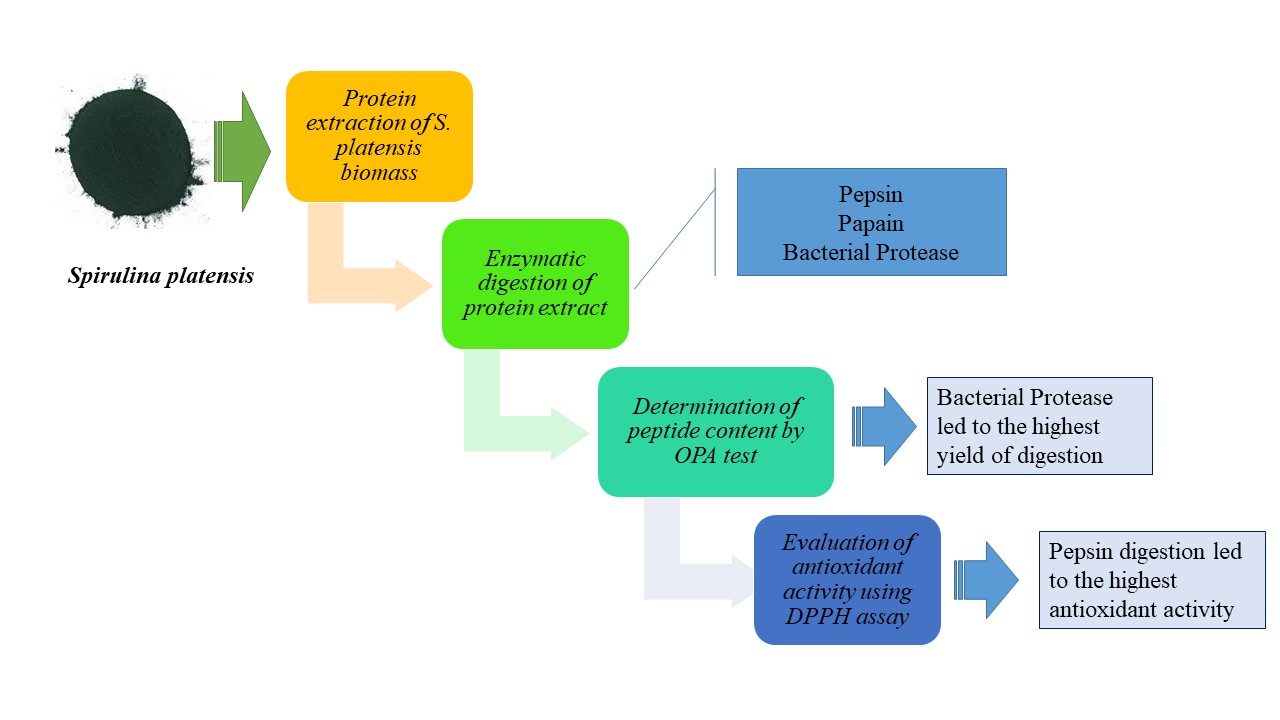Antioxidant Activity of Peptides Derived from Enzymatic Digestion of Spirulina platensis Protein Extract by Different Proteases Antioxidant activity of protein digests of S. platensis
Trends in Peptide and Protein Sciences,
Vol. 7 (2022),
7 March 2022
,
Page 1-7 (e6)
https://doi.org/10.22037/tpps.v7i.38965
Abstract
One of the attractive sources of bioactive compounds is cyanobacteria and in particular, Chlorella vulgaris and Spirulina platensis. Enzymatic digestion of the Spirulina protein extract can result in bioactive peptides with diverse activities, including antioxidant function. This study aims to produce peptides with antioxidant properties after the enzymatic digestion of Spirulina platensis protein extract using three enzymes: bacterial protease, pepsin, and papain. The protein extract from Spirulina platensis was subjected to enzyme hydrolysis for 3 hours at 37°C (pH 7.4 for papain and bacterial protease and pH 5 for pepsin). The concentration of peptide fragments was evaluated to determine the yield of protein digestion. In order to measure the level of anti-oxidative potential of the hydrolysates, the DPPH assay was run. The results indicated that the bacterial protease led to the highest concentration of peptide fragments, while the hydrolysate obtained from pepsin digestion showed the most antioxidant activity (80%), mainly the peptides that have molecular weights less than 14 KDa. Consequently, pepsin can be a proper enzyme to produce antioxidant peptides from the protein extract of S. platensis. In conclusion, the results of the study confirmed that the products of enzymatic digestion by different enzymes have distinct features.
HIGHLIGHTS
- Spirulina platensis protein extract was digested with three types of protease.
- Digestion of protein extract by pepsin resulted in higher antioxidant activity.
- Digestion by bacterial protease from Bacillus licheniformis resulted in higher yield of peptide formation.
- Cyanobacteria
- Spirulina platensis
- Protein extraction
- Protease digestion
- Antioxidant
- DPPH

How to Cite
References
Bradford, M.M. (1976). "A rapid and sensitive method for the quantitation of microgram quantities of protein utilizing the principle of protein-dye binding." Analytical Biochemistry, 72(1): 248-254.
de Torre, M. P., Cavero, R.Y., Calvo, M.I. and J.L. Vizmanos, (2019). "A simple and a reliable method to quantify antioxidant activity in vivo." Antioxidants, 8(5): 142.
Gogineni, V. and M.T. Hamann, (2018). "Marine natural product peptides with therapeutic potential: Chemistry, biosynthesis, and pharmacology." Biochimica et Biophysica Acta (BBA) - General Subjects, 1862(1): 81-196.
Grosshagauer, S., Kraemer, K. and V. Somoza, (2020). "The true value of Spirulina." Journal of Agricultural and Food Chemistry, 68(14): 4109-4115.
Han, P., Li, J., Zhong, H., Xie, J., Zhang, P., Lu, Q., Li, J., Xu, P., Chen, P., Leng, L. and W. Zhou, (2021). "Anti-oxidation properties and therapeutic potentials of spirulina." Algal Research, 55: 102240.
Jena, J. and E. Subudhi, (2019). "Microalgae: An Untapped Resource for Natural Antimicrobials. " In: Sukla, L.B., Subudhi, E. and D. Pradhan (Eds), The Role of Microalgae in Wastewater Treatment. Singapore, Springer Singapore, pp. 99-114.
Moaveni, S., Salami, M., Khodadadi, M., McDougall, M. and Z. Emam-Djomeh, (2022). "Investigation of S.limacinum microalgae digestibility and production of antioxidant bioactive peptides." LWT - Food Science and Technology, 154: 112468.
Mohajeri, R.I., Mirzaei, M. and H. Ofoghi, (2019). " Effects of enzyme types and hydrolysis time on the production of antioxidant peptides from Spirulina platensis " Innovative Food Technologies, 6(4): 583-599.
Mohammadi, M., Soltanzadeh, M., Ebrahimi, A.R. and H. Hamishehkar, (2022). "Spirulina platensis protein hydrolysates: Techno-functional, nutritional and antioxidant properties." Algal Research, 65: 102739.
Montalvo, G.E.B. (2018). "Discovery of novel bioactive peptides from Spirulina (Arthrospira) maxima." Universidade Federal do Tocantins, Programa de Pós-Graduação em Biotecnologia, Gurupi, 2018.
Nouri, E. and H. Abbasi, (2018). "Effects of different processing methods on phytochemical compounds and antioxidant activity of Spirulina platensis." Applied Food Biotechnology, 5(4): 221-232.
Ovando, C.A., Carvalho, J.C.d., Vinícius de Melo Pereira, G., Jacques, P., Soccol, V.T. and C.R. Soccol, (2018). "Functional properties and health benefits of bioactive peptides derived from Spirulina: A review." Food Reviews International, 34(1): 34-51.
Raja, R., Hemaiswarya, S., Ganesan, V. and I.S. Carvalho, (2016). "Recent developments in therapeutic applications of Cyanobacteria." Critical Reviews in Microbiology, 42(3): 394-405.
Raufman, J.-P. (2004). "Pepsin. " In: Johnson, L.R. (Ed), Encyclopedia of Gastroenterology. New York, Elsevier, pp. 147-148.
Rizzello, C.G., Lorusso, A., Russo, V., Pinto, D., Marzani, B. and M. Gobbetti (2017). "Improving the antioxidant properties of quinoa flour through fermentation with selected autochthonous lactic acid bacteria." Internatioanl Journal of Food Microbiology, 241: 252-261.
Rutherfurd, S.M. (2010). "Methodology for determining degree of hydrolysis of proteins in hydrolysates: A review." Journal of AOAC International, 93(5): 1515-1522.
Ru¨tti, M.F., Richard, S., Penno, A., von Eckardstein, A. and T. Hornemann, (2009). "An improved method to determine serine palmitoyltransferase activity." Journal of Lipid Research, 50(6): 1237-1244.
Saad, M.H., El-Fakharany, E.M., Salem, M.S. and N.M. Sidkey, (2022). "The use of cyanobacterial metabolites as natural medical and biotechnological tools: review article." Journal of Biomolecular Structure and Dynamics, 40(6): 2828-2850.
Soni, R.A., Sudhakar, K. and R.S. Rana, (2017). "Spirulina – From growth to nutritional product: A review." Trends in Food Science & Technology, 69: 157-171.
Sun, Y., Chang, R., Li, Q. and B. Li, (2016). "Isolation and characterization of an antibacterial peptide from protein hydrolysates of Spirulina platensis." European Food Research and Technology, 242(5): 685-692.
Tabarzad, M., Atabaki, V. and T. Hosseinabadi, (2020). "Anti-inflammatory activity of bioactive compounds from microalgae and cyanobacteria by focusing on the mechanisms of action." Molecular Biology Reports, 47(8): 6193-6205.
Verma, S., Dixit, R. and K.C. Pandey, (2016). "Cysteine Proteases: Modes of Activation and Future Prospects as Pharmacological Targets." Frontiers in Pharmacology, 7: 107.
Wu, Q., Liu, L., Miron, A., Klímová, B., Wan, D. and K. Kuča, (2016). "The antioxidant, immunomodulatory, and anti-inflammatory activities of Spirulina: an overview." Archives of Toxicology, 90(8): 1817-1840.
- Abstract Viewed: 257 times
- PDF Downloaded: 178 times